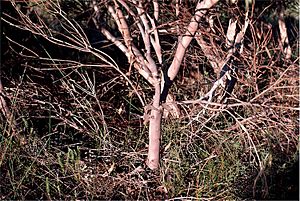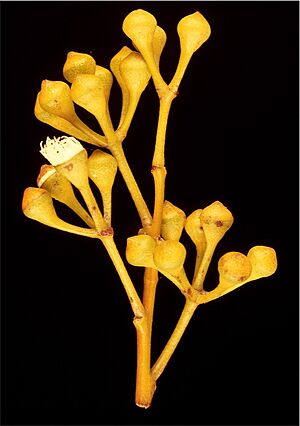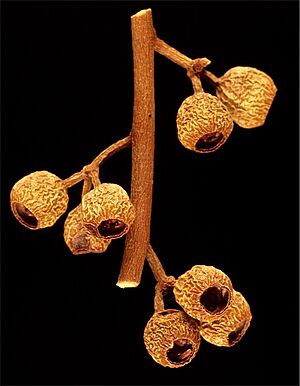Johnson's mallee facts for kids
Quick facts for kids Johnson's mallee |
|
|---|---|
 |
|
| Conservation status | |
| Scientific classification | |
| Genus: |
Eucalyptus
|
| Species: |
johnsoniana
|
Johnson's mallee (scientific name: Eucalyptus johnsoniana) is a special type of eucalyptus tree. It only grows in Western Australia, which means it is endemic there. This plant has smooth, grey-brown bark. Sometimes, its bark can be a bit rough and flaky near the bottom.
Its leaves are shaped like a spear. The flowers are creamy white and grow in groups of seven. After flowering, it produces small, round fruits. These fruits have a very tiny opening.
Contents
What Does Johnson's Mallee Look Like?
Johnson's mallee is a type of mallee plant. It usually grows to be about 1 to 3.5 meters (3 to 11 feet) tall. This plant has a special woody base called a lignotuber. This helps it regrow after a fire.
Bark and Leaves
The bark on Johnson's mallee is mostly smooth. It has a greyish-brown color. Sometimes, the bark near the ground can be rough and flaky. Young plants have dull, bluish-green leaves. These leaves are egg-shaped or oval. They are about 3 to 11 centimeters (1 to 4 inches) long.
Adult leaves are shaped like a spear. They are about 5.5 to 10.5 centimeters (2 to 4 inches) long. These leaves grow on a small stalk called a petiole.
Flowers and Fruit
The flower buds grow in groups of seven. Each group sits on a stalk called a peduncle. The buds themselves are oval or pear-shaped. They are about 5 to 6 millimeters long. Each bud has a rounded cap called an operculum.
Johnson's mallee flowers are creamy white. They usually bloom from July to August. They can also flower from October to January. After the flowers, the plant makes a woody fruit. This fruit is a round capsule. It has a very small opening.
How Johnson's Mallee Got Its Name
Discovery and Naming
Eucalyptus johnsoniana was first officially described in 1978. Two scientists, Ian Brooker and Donald Blaxell, wrote about it. Blaxell found a sample of the plant in 1975. He found it near the Brand Highway in Western Australia.
The plant was named after Dr. Lawrie Johnson. He was the Director of the Royal Botanic Garden, Sydney. The name honors his work in botany.
Where Does Johnson's Mallee Grow?
Johnson's mallee grows in Western Australia. It prefers sandy plains with low, open shrubs. You can find it mostly between the towns of Eneabba and Badgingarra.
Why Johnson's Mallee Needs Our Help
Conservation Status
This special mallee is considered "vulnerable." This means it is at risk of disappearing. The Australian Government lists it as "vulnerable" under the Environment Protection and Biodiversity Conservation Act 1999. The Department of Environment and Conservation (Western Australia) also calls it "Threatened Flora."
Threats to the Plant
Scientists estimate there are only about 360 Johnson's mallee plants left. This small number makes them very fragile. The main dangers to these plants are:
- Bushfires: Fires can harm or destroy the plants.
- Land Clearing: Areas where they grow are sometimes cleared for other uses.
- Power Line Maintenance: Work on power lines can disturb their habitat.
Protecting these plants is important. It helps keep our natural world diverse and healthy.




